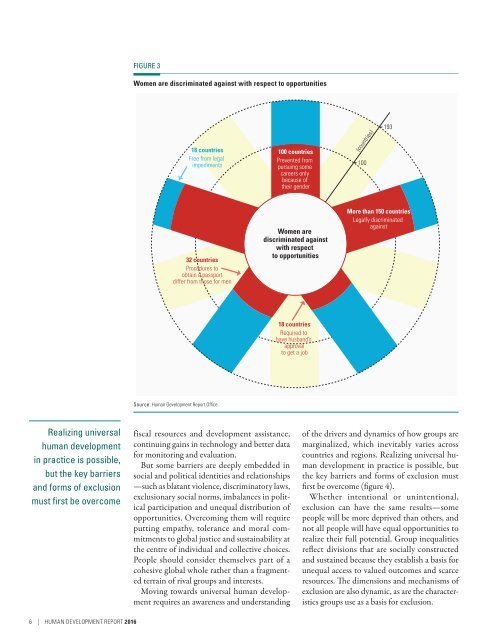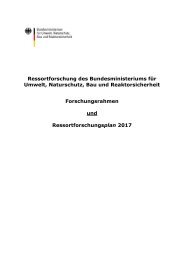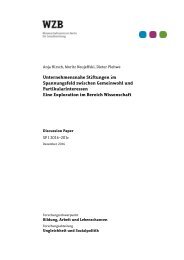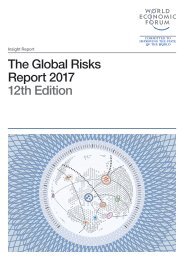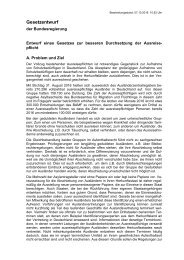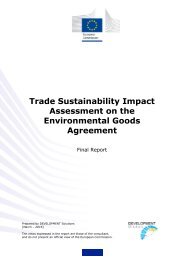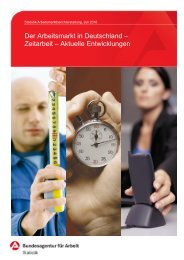- Page 1 and 2: Human Development Report 2016 Human
- Page 3 and 4: Human Development Report 2016 Human
- Page 5 and 6: Human Development Report 2016 Human
- Page 7 and 8: Human Development Report 2016 Human
- Page 9 and 10: Contents Foreword Acknowledgements
- Page 11: 2.5 In the United States the Human
- Page 14 and 15: Infographic 1 Human development for
- Page 16 and 17: FIGURE 1 Human development — the
- Page 18 and 19: Closing the human development gaps
- Page 22 and 23: Voice and autonomy, as parts of fre
- Page 24 and 25: FIGURE 5 National policies to care
- Page 26 and 27: Because half of humanity is not enj
- Page 28 and 29: Pursuing measures for groups with s
- Page 30 and 31: are more indirect ways of accuratel
- Page 32 and 33: The time has come to examine the re
- Page 34 and 35: SPECIAL CONTRIBUTION Peace in Colom
- Page 37 and 38: Chapter 1 Human development — ach
- Page 39 and 40: 1. Human Development Report 2016 Hu
- Page 41 and 42: FIGURE 1.1 Regional trends in Human
- Page 43 and 44: technology and create value can thr
- Page 45 and 46: 0.63 in 2010, driven by declining i
- Page 47 and 48: BOX 1.3 Insights based on horizonta
- Page 49 and 50: in 2013, 453 million people — 190
- Page 51 and 52: 56 million people are trapped in a
- Page 53 and 54: 1 billion people worldwide lack acc
- Page 55 and 56: people — access to dynamic price
- Page 57 and 58: including the United Nations. 184 A
- Page 59 and 60: gas emissions are now covered by ca
- Page 61: FIGURE 1.10 Analytical links betwee
- Page 64 and 65: Infographic 2.1 Barriers to univers
- Page 66 and 67: One of the main challenges of pract
- Page 68 and 69: The deprivations facing women are t
- Page 70 and 71:
Viewing the nation as the primary u
- Page 72 and 73:
Gender disparities in human develop
- Page 74 and 75:
FIGURE 2.4 Variations in Human Deve
- Page 76 and 77:
BOX 2.4 Limitations in opportunitie
- Page 78 and 79:
BOX 2.5 Disadvantages facing migran
- Page 80 and 81:
FIGURE 2.6 Since the 1990s attitude
- Page 82 and 83:
People are living longer but also s
- Page 84 and 85:
Epidemics, violence, climate change
- Page 86 and 87:
FIGURE 2.8 Deprivations among women
- Page 88 and 89:
Fulfilling basic needs is an essent
- Page 90 and 91:
Whether intentional or unintentiona
- Page 92 and 93:
Legal and political institutions ca
- Page 94 and 95:
Extreme inequality and the concentr
- Page 97 and 98:
Chapter 3 Reaching everyone— anal
- Page 99 and 100:
Human Development 3. Report 2016 Hu
- Page 101 and 102:
and participation are both a means
- Page 103 and 104:
Human decisionmaking — to be exam
- Page 105 and 106:
SPECIAL CONTRIBUTION How important
- Page 107 and 108:
value. This absence can be a seriou
- Page 109 and 110:
Somalia’s 2012 National Human Dev
- Page 111 and 112:
BOX 3.4 Test score methods for asse
- Page 113 and 114:
FIGURE 3.4 The trend in nonincome H
- Page 115 and 116:
FIGURE 3.5 Human development indica
- Page 117 and 118:
Chapter 4 Caring for those left out
- Page 119 and 120:
Human Development 4. Report 2016 Hu
- Page 121 and 122:
BOX 4.1 The Global Deal — a tripl
- Page 123 and 124:
of Ouagadougou’s nearly 2 million
- Page 125 and 126:
Providing autonomy to local governm
- Page 127 and 128:
care centres, afterschool programme
- Page 129 and 130:
young people with the skills needed
- Page 131 and 132:
to improve the governance, institut
- Page 133 and 134:
made a difference is in women’s r
- Page 135 and 136:
SPECIAL CONTRIBUTION The world has
- Page 137 and 138:
BOX 4.12 Providing work to Syrian r
- Page 139 and 140:
occurred at the beginning of 2015 i
- Page 141 and 142:
Addressing climate change Climate c
- Page 143 and 144:
BOX 4.17 Mainstreaming the poverty-
- Page 145 and 146:
FIGURE 4.5 Many countries have not
- Page 147:
BOX 4.20 Right to information — a
- Page 150 and 151:
Infographic 5.1 Challenges and refo
- Page 152 and 153:
Collective decisions shape global i
- Page 154 and 155:
The current architecture of interna
- Page 156 and 157:
The rules that govern international
- Page 158 and 159:
BOX 5.4 Bilateral investment treati
- Page 160 and 161:
Global social movements have spotli
- Page 162 and 163:
Macroeconomic coordination among la
- Page 164 and 165:
Since displacement lasts on average
- Page 166 and 167:
Today’s new realities and aspirat
- Page 168 and 169:
FIGURE 5.6 Developing countries wou
- Page 170 and 171:
The existing multilateral instituti
- Page 172 and 173:
SPECIAL CONTRIBUTION Preventing vio
- Page 174 and 175:
The transformation of global instit
- Page 176 and 177:
Infographic 6.1 Human development f
- Page 178 and 179:
FIGURE 6.1 Reaching everyone — ti
- Page 180 and 181:
The Sustainable Development Goals,
- Page 182 and 183:
BOX 6.3 The New York Declaration
- Page 185 and 186:
Notes Overview 1 UNFPA 2014. 2 Unit
- Page 187 and 188:
134 Darrow and Tomas 2005; Johnson
- Page 189 and 190:
References Abadeer, A.S.Z. 2015. No
- Page 191 and 192:
Dreher, A., J. Sturm and J. Vreelan
- Page 193 and 194:
Washington, Seattle. www.healthdata
- Page 195 and 196:
McGinn, K.L., M.R. Castro and E.L.
- Page 197 and 198:
2016. United Nations Development Pr
- Page 199 and 200:
———. 2016g. “Legal Aid Serv
- Page 201 and 202:
———. 2016b. “Passing and Im
- Page 203:
Human Development Reports 1990-2016
- Page 207 and 208:
Readers guide The 17 statistical ta
- Page 209 and 210:
HUMAN DEVELOPMENT REPORT 2016 Human
- Page 211 and 212:
Human development composite indices
- Page 213 and 214:
HUMAN DEVELOPMENT REPORT 2016 Human
- Page 215 and 216:
HUMAN DEVELOPMENT REPORT 2016 Human
- Page 217 and 218:
HUMAN DEVELOPMENT REPORT 2016 Human
- Page 219 and 220:
HUMAN DEVELOPMENT REPORT 2016 Human
- Page 221 and 222:
HUMAN DEVELOPMENT REPORT 2016 Human
- Page 223 and 224:
HUMAN DEVELOPMENT REPORT 2016 Human
- Page 225 and 226:
HUMAN DEVELOPMENT REPORT 2016 Human
- Page 227 and 228:
HUMAN DEVELOPMENT REPORT 2016 Human
- Page 229 and 230:
HUMAN DEVELOPMENT REPORT 2016 Human
- Page 231 and 232:
HUMAN DEVELOPMENT REPORT 2016 Human
- Page 233:
HUMAN DEVELOPMENT REPORT 2016 Human
- Page 236 and 237:
TABLE 7 Population trends Total Pop
- Page 238 and 239:
TABLE 7 POPULATION TRENDS Total Pop
- Page 240 and 241:
TABLE 8 Health outcomes TABLE 8 Inf
- Page 242 and 243:
TABLE 8 HEALTH OUTCOMES TABLE 8 Inf
- Page 244 and 245:
TABLE 9 Education achievements TABL
- Page 246 and 247:
TABLE 9 EDUCATION ACHIEVEMENTS TABL
- Page 248 and 249:
TABLE 10 National income and compos
- Page 250 and 251:
TABLE 10 NATIONAL INCOME AND COMPOS
- Page 252 and 253:
TABLE 11 Work and employment Employ
- Page 254 and 255:
TABLE 11 WORK AND EMPLOYMENT TABLE
- Page 256 and 257:
TABLE 12 Human security TABLE 12 Bi
- Page 258 and 259:
TABLE 12 HUMAN SECURITY TABLE 12 Bi
- Page 260 and 261:
TABLE 13 International integration
- Page 262 and 263:
TABLE 13 INTERNATIONAL INTEGRATION
- Page 264 and 265:
TABLE 14 Supplementary indicators:
- Page 266 and 267:
TABLE 14 SUPPLEMENTARY INDICATORS:
- Page 268 and 269:
TABLE 15 Status of fundamental huma
- Page 270 and 271:
TABLE 15 STATUS OF FUNDAMENTAL HUMA
- Page 272 and 273:
Human development dashboards
- Page 274 and 275:
DASHBOARD 1 LIFE-COURSE GENDER GAP
- Page 276 and 277:
DASHBOARD 1 LIFE-COURSE GENDER GAP
- Page 278 and 279:
DASHBOARD 2 Sustainable development
- Page 280 and 281:
DASHBOARD 2 SUSTAINABLE DEVELOPMENT
- Page 282 and 283:
DASHBOARD 2 SUSTAINABLE DEVELOPMENT
- Page 284 and 285:
Statistical references Barro, R.J.,
- Page 286:
United Nations Development Programm


